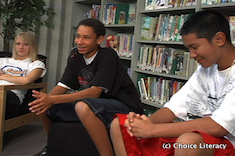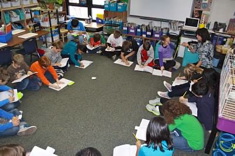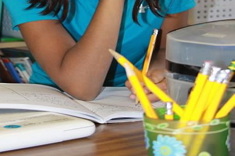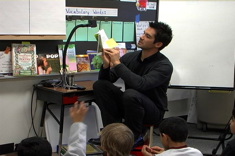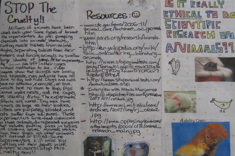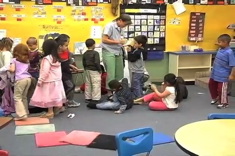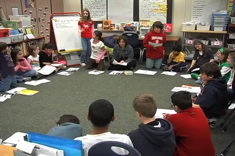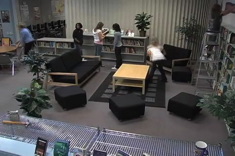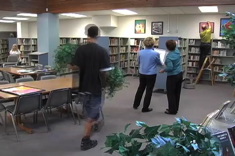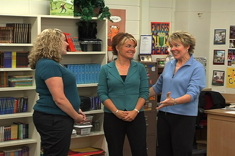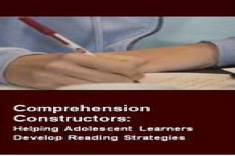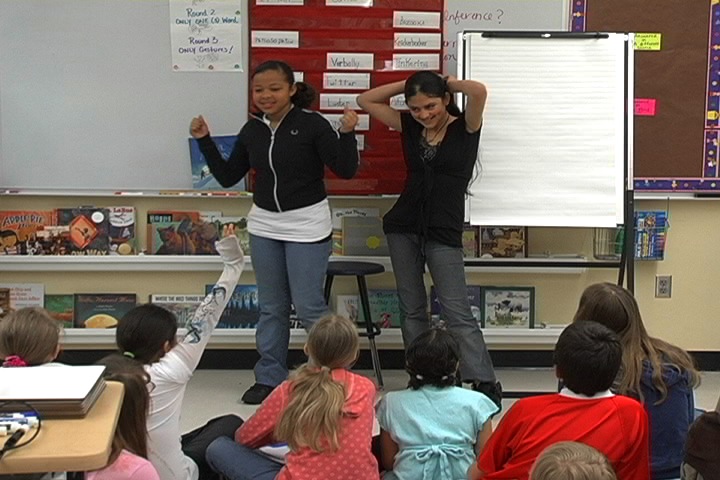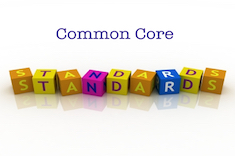9th
Latest Content
Educating the Writer’s Palate
Helping high school students understand the sophisticated literary tastes of writers is just a cookie away in Ellie Gilbert’s classroom. Ellie pairs cardamon with irony to launch the school year with a metaphor and challenge.
Worldwide Cinderellas
Erin Ocon discovers that worldwide Cinderella stories are a wonderful tool for building community and cultural awareness in her seventh-grade classroom and with English language learners. Erin describes how she uses a range of Cinderella picture books with students, and provides an extensive booklist for expanding your library.
Top 10 Technology Tools for Teachers
If you're overwhelmed with the slew of new technology tools coming out all the time (and who isn't?), you might appreciate Scott Sibberson's Top 10 Tech Tools for Teachers. You are probably using some of the tools daily, and may discover a few new ones too.
No More Excuses: Reading Workshops in Nontraditional Middle and High School Settings
Think you don’t have enough time for reader’s workshop in your classroom? Worried that you don’t have enough books to go around? Feel like you just don’t have the space for it? What if you had students, but no classroom, no books, and no set class times? Ellie Gilbert faced down all these challenges in her nontraditional high school reading workshop.
One Book/Four Hands: Mentoring Younger Readers Using Picture Books
Paul Hankins describes the power of pairing high school and elementary students in a partner reading program.
High School Students Take on a Reader’s Bill of Rights
Ellie Gilbert revisits the “rights of readers” with her high school students,revising the list based on their habits and preferences. The discussion leads to some surprising additions to the list of rights. This would be a fun activity to close out the school year, or to begin a summer program with children of almost any age.
Using Animated Short Films to Teach Inference
Here’s a problem many teachers share – students are far too literal when it comes to inferring while reading. Ellie Gilbert finds animated short films readily available on the web are a terrific tool for helping students move beyond literal interpretations of text.
Beginning with the End in Mind: Planning Ahead for Closing Activities
Choice Literacy readers share their favorite end-of-year activities that circle back to events from the start of the school year.
Pencil Plans
The care and use of the lowly pencil in classrooms says a lot about what we value and our relationships with students.
Read Alouds for the First Day of School
Choice Literacy readers share their favorite read alouds for the start of the year.
A District Film Festival: Giving Kids An Authentic Audience for Their Work
Lights, cameras, and even a red carpet! Bill Bass documents how a film festival brought high school teachers and students together, with a strong focus on connecting district goals and standards to the fun projects.
Persuasive Pamphlets
Erin Ocon and her middle-school students observe some political activists passing out pamphlets outside the building for a few moments. Voila – the pamphlet project is born. Pamphlets are the perfect genre for teaching persuasion and summary, two key skills highlighted in the Common Core.
Pamphlets on Books (Part 2 of the Persuasive Pamphlets Series)
Erin Ocon finds pamphlets are a terrific format for teaching her middle-school students persuasive writing and summary skills. In this essay she explains how to use pamphlets for book recommendations. This is the second installment in a two-part series.
Characters I Know Too Well
Books with themes of sexual abuse may be the most difficult for many of us to grapple with, if only because the issue horrifies us. Yet for some abused teens, a book may be the needed catalyst for breaking their silence about what's going on outside school. Andie Cunningham shares an annotated booklist on this tough topic.
Read Alouds for the Last Days of School
Choice Literacy readers share some of their favorite read alouds for the last days of school.
Literacy Keepsakes to Carry Home at the End of the School Year
Choice Literacy readers share their favorite gifts for students to make and take home at the end of the year.
Writing and Publishing Book Reviews with Middle School Students
What teenager doesn't enjoy critiquing everything in the world? Erin Ocon puts that judgmental passion to good use in her classroom with a book review assignment.
More Literacy Keepsakes to Carry Home at the End of the School Year
Choice Literacy readers share more of their favorite end-of-year gifts for students to make and take home.
Sarcasm Is a Useful Teaching Tool — NOT
How does sarcasm hurt students? Heather Rader counts the ways.
Getting and Giving Student Feedback
How can we help students be more reflective in our classrooms, giving us the feedback we need to make them better places for learning? Heather Rader has suggestions.
Twitter Me This: Using Cell Phones to Build Literacy Skills and a Reading Community
Lisa Koch found herself a bit irritated as her high school students would discreetly send text messages as she tried to teach them literary terms. Her solution? Tweet tweet! You can read here about her successful summer experiment of tweeting literary terms and staying in touch with students over summer reading assignments.
Middle School Classroom Makeover Part I
In this first of a three-part video series, “The Sisters” (Gail Boushey and Joan Moser) help 7th grade teacher Erin declutter and rearrange her classroom.
Middle School Library Makeover Part I
In this first of a two-part video series, “The Sisters” (Joan Moser and Gail Boushey) work with students, a librarian, and a principal to makeover a middle-school library. This first installment features the creation of a “cozy area” and new book browsing displays.
Middle School Library Makeover Part II: Stacks and Recap
The Sisters (Gail Boushey and Joan Moser) collaborate with a middle school librarian, principal, and team of students to makeover the school library. In this final segment of the series, they redo the stacks and meeting area, and then talk with students about the transformation of the entire library.
Middle School Classroom Makeover Part III
In this third installment of a three-part video series, “The Sisters” (Gail Boushey and Joan Moser) help 7th grade teacher Erin declutter and rearrange her classroom. This installment focuses on the challenges of classrooms with very little storage space.
Middle School Classroom Makeover Part II
In this second of a three-part video series, “The Sisters” (Gail Boushey and Joan Moser) help seventh-grade teacher Erin declutter and rearrange the media area of the classroom, creating a cozy library space.
Designing Comprehension Constructors: Helping Adolescent Learners Develop Reading Strategies (E-GUIDE)
Comprehension constructors are a terrific tool for helping teens record their understanding.
The Read-Around: Raising Writers
If there was a centerpiece to teaching writing that also brought students closer together, wouldn't you want to know about it? Read on about the Read-Around.
Let’s Get Some Attitude
Shirl McPhillips recalls a junior high experience that promoted serious "attitude" and an uproar among her peers.
Common Core Conversations: Increasing Argumentative Writing
Teachers continue to puzzle over and sort through the terminology in the Common Core related to opinion and persuasive writing. Amanda Adrian and Heather Rader consider terms and teaching strategies.
Browse Content By
Type
Category
- Assessment Tools
- Big Fresh Archives
- Booklists
- Choice Numeracy
- Classroom Design
- Common Core
- Community Building
- Conferring
- Content Literacy
- Digital Literacy
- English Language Learners
- Equity
- Family Relations
- Free Samples
- Guiding Groups
- Leadership
- Literacy Coaches
- Mentor Texts
- Minilessons
- New Teacher Mentors
- Podcasts
- Poetry
- Quote Collections
- Reading Strategies
- Self Care
- Struggling and Striving Learners
- Talking and Listening
- Teacher Study Groups
- Teaching Reading
- Teaching Writing
- Word Study and Vocabulary
Author
- Melissa Quimby
- Nawal Qarooni
- Gwen Blumberg
- Julie Cox
- The Lead Learners
- Hannah Tills
- Josie Stewart
- Ruth Metcalfe
- Mallory Messenger
- Becca Burk
- Jodie Bailey
- Vivian Chen
- Mary Brower
- Tiffany Abbott Fuller
- Stephanie Affinito
- Ruth Ayres
- Leigh Anne Eck
- Heather Fisher
- Shari Frost
- Julie Johnson
- Suzy Kaback
- Gigi McAllister
- Shirl McPhillips
- Melanie Meehan
- Cathy Mere
- Debbie Miller
- Tara Barnett and Kate Mills
- Tammy Mulligan
- Dana Murphy
- Bitsy Parks
- David Pittman
- Brenda Power
- Heather Rader
- Matt Renwick
- Mandy Robek
- Christy Rush-Levine
- Gretchen Schroeder
- Jen Schwanke
- Brian Sepe
- Katherine Sokolowski
- Stella Villalba
- Jennifer Vincent
Grade Level
Choice Literacy Membership
Articles
Get full access to all Choice Literacy article content
Videos
Get full access to all Choice Literacy video content
Courses
Access Choice Literacy course curriculum and training






